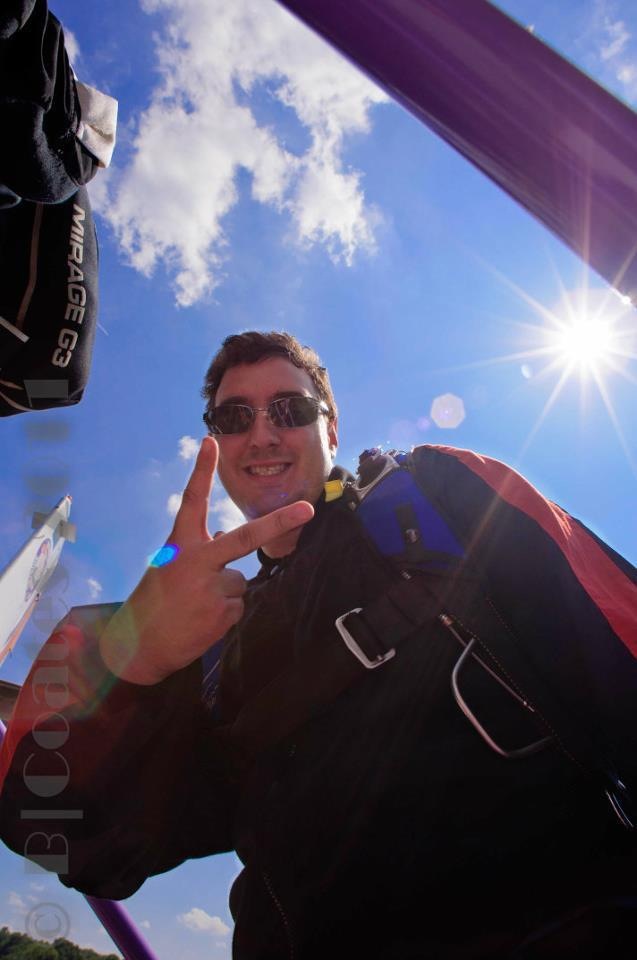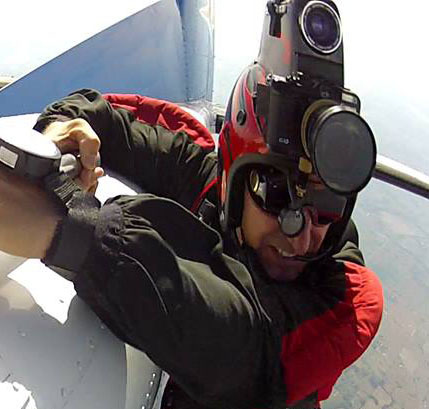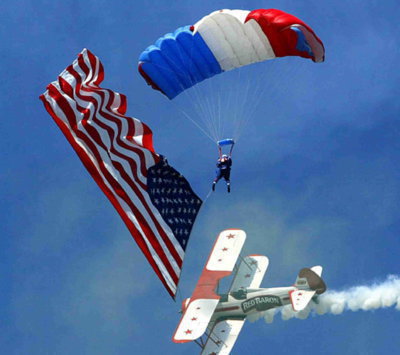Recommended Posts
erdnarob 1
In case of a pilot chute in tow, I figure out that if the pilot chute drag (over 100 pounds) is not able to provide a deployment, well, the main is going to stay in the container. Therefore, cutting away is a waste of time and useless. Now before pulling the reserve and in order to avoid a reserve/pilot chute entanglement, I would slightly dive (10-15 degrees) while lowering one shoulder to give the pilot chute less chance to stay in the burble and to let it go with no hesitation and fast.
kkeenan 14
Quote...I figure out that if the pilot chute drag (over 100 pounds) is not able to provide a deployment, well, the main is going to stay in the container. Therefore, cutting away is a waste of time and useless.
I happen to agree with you about not cutting away before pulling the reserve, but not because I don't think the main will not come out of he container. It very well may come out. You have to be prepared for this.
The configuration of the container will change as soon as the reserve bag leaves, so it is very possible that whatever condition is preventing the main from leaving will then allow it to go. By delaying the possible cutaway of the main until after reserve deployment, you avoid the uncontrolled release of the main risers until you can do it in a controlled manner.
Kevin K.
Dude, you are so awesome...
Can I be on your ash jump ?
erdnarob 1
Too bad we don't have any statistics about the pilot chute in tow and the possible release of the main after the reserve deployment and the consequences. I wonder if the US army made such a testing. If that is going to happen I have the feeling that the reserve will beat the main for inflation.
Anyway, having the main released when the reserve is open, risers cut away or not you still can get an entanglement between the main risers (if released) and lines and reserve isn't it ? ![]()
I had a pilot chute in tow mal, on my 153rd jump. I rolled a little right in hope it was in my burble. Nothing. Then left. Nothing. Did the EPs I was taught. Cutaway, then reserve. I am glad I cutaway, as when the reserve came out it loosened the maintray enough, that the pin pulled out and released the dbag. I shudder to think of that wad of crap ending up entangled in my deploying reserve. If I ever have another one, I will do exactly the same thing. Drank a lot that night after that one BTW.![]()
Andy9o8 3
QuoteI would slightly dive (10-15 degrees) while lowering one shoulder to give the pilot chute less chance to stay in the burble and to let it go with no hesitation and fast.
I agree with any effort to get the pilot chute out of the burble and fast. To me a pilot chute bouncing around no my back would for sure be likely to entangle with my main bridle.
I dont know about the dive though. This has been discussed here before. Pitching your body in either direction (diving or back sliding) only brings the main pc and the deploying reserve free bag closer together. Personally I would prefer to keep these two as far apart as possible by keeping my body flat on the pitch axes.
A bit of bank (droping one shoulder) sounds like sound reasoning to me.
erdnarob 1
abyzet 0
I was taught to go right to silver. I would rather have a two out, and deal with that, than have a bow-tied reserve. If it turns into a two out, then I'll work that issue.![]()
1. Pilot chutes and their bridles do not fly well! They dance around wildly in the burble.
2. The result of this action and the pull from the PC can affect your attitude (angle of fall).
3. Having a predetermined plan is a good idea!!!
That being said, I reached around (remember my altitude) grabbed the bridal and gave one good tug. Out came the main, I made it back to the CRW dive…
However, trying to grab a dancing bridle can quickly get you into serious trouble. My predetermined plan is to roll slightly left, slightly right (to change the burble), if that doesn’t work, Hi Ho Silver!
My altitude allowed me the opportunity to try pulling the bridle. I’ve had this conversation with instructors and students alike. There is no question what I would do in this situation… Follow my emergency procedures as practiced!!!!!
"Son, only two things fall from the sky."
QuoteThe PCIT issue makes me wonder what the state of affairs would be had the pull-out handily won the popularity contest with the throw-out, rather than the converse.
For years I always jumped a pull-out for that reason, as well as not having spandex to maintain/replace...Then I heard Booth explain the advantages/disadvantages, and why the throw out is actually more in keeping within design parameters
regarding function and safety.
There may even be a thread somewhere on here that Bill contributed to regarding the issue.
Personally, I've never had a PCIT, but would go with option one, pull stable and pray. Had a guy tell me once that he'd hook knifed a PCIT in order to get a clean reserve deployment...I just smiled and nodded.
~ If you choke a Smurf, what color does it turn? ~
mixedup 0
1) In case of a PCIT the "go straight for silver" option advantage seems to be based on the fact that if your main does come out at the same time as the reserve it should not entangle? I assume this is because the mains risers would obviously hold it back, but I'm just wondering to what extent the main and reserve could still entangle even if main's still attached anyway? Is this still a possibility, but much less than the change of an entanglement when the main is cut away and then deploys at the same time as the reserve?
2) If you have a Pilot Chute Hesitation which you can't clear (which perhaps seems unlikely if you follow the normal approach to clear this?, so perhaps this is an unlikely thing to have to worry about?), then would the "PCIT go straight for silver" argument equally apply here?
cheers
PS. I am not asking this for my own EPs which I already have, rather just interested in learning more about this area...
QuoteCan I ask if someone could explain a couple of items here:
1) In case of a PCIT the "go straight for silver" option advantage seems to be based on the fact that if your main does come out at the same time as the reserve it should not entangle?
No. That's not the main advantage.
The advantage is two-fold:
-altitude conservation
-potential main/reserve disentanglement
QuoteI'm just wondering to what extent the main and reserve could still entangle even if main's still attached anyway? Is this still a possibility, but much less than the change of an entanglement when the main is cut away and then deploys at the same time as the reserve?
Either can happen and has done so in several cases.
The problem is there are no stats or tests that show unequivocally that one is more advantageous than the other. I'd call it 50/50 for no other reason than "I don't know for sure."
Quote2) If you have a Pilot Chute Hesitation which you can't clear (which perhaps seems unlikely if you follow the normal approach to clear this?, so perhaps this is an unlikely thing to have to worry about?), then would the "PCIT go straight for silver" argument equally apply here?
Please post that question in its own thread.
I think we're all Bozos on this bus.
Falcon5232, SCS8170, SCSA353, POPS9398, DS239
QuoteFrom UFK22:The biggest advantage to pulling both handles is that it eliminates the decision time for "do I pull one or both" from the process. Instead of a second or two lost deciding on which EP to follow, just execute.
If you were trained to cutaway and deploy reserve no matter what the emergency, you might have a point. Otherwise, you just execute what you were taught and have drilled.
QuoteFrankly, I'm surprised at how many people are dismissive of this issue. It is a REAL issue. The time wasted in deciding what to do, for MANY people, almost certainly takes more time than the extra second to pull a red handle.
Regardless of what or how you were taught, if you have not adequately trained yourself to handle the different emergencies, you get what you pay for. You will be hesitant or even worse, do the wrong thing at the wrong time or even worse yet, do nothing at all.
QuoteThe "decision time" is reduced as people have more jumps, are more comfortable in the air, are more current and have adequately trained themselves
FIFY
Quotehowever, Thus the right answer for a student may not be the right answer for someone that jumps every weekend and has thousands of jumps.
True dat. You may know that students do oddball things no matter what or how they are trained. We can only do our best and hope for the best.
I do NOT teach the one-size-fits-all concept.
I think we're all Bozos on this bus.
Falcon5232, SCS8170, SCSA353, POPS9398, DS239







I haven't been here since my last post and reading all the came after, I was surprised that it took so long for this to be mentioned.
Thanks Kevin.
I think we're all Bozos on this bus.
Falcon5232, SCS8170, SCSA353, POPS9398, DS239
Share this post
Link to post
Share on other sites